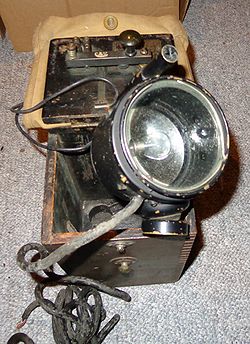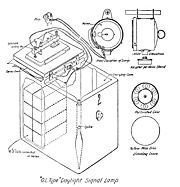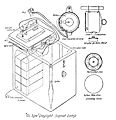Lamp Electric Signalling Daylight
| Lamp Electric Signalling Daylight | |
|---|---|
 "Lucas Lamp" | |
| Production history | |
| Introduced | 1916 |
The "Lucas Lamp" was invented by Oliver Lucas in 1916 and patented by him – hence the use of the "O.L. Type" name sometimes found. While many of them were made by Joseph Lucas, Ltd., even those made by other companies were still "Lucas Lamps".
Description
THE "O.L." DAYLIGHT SIGNALLING OR "LUCAS" LAMP. (FIRST PATTERN)[1]
The set consists of a wooden box, with a leather sling for carrying, containing the lamp, 6 feet of flexible lead and plug, spike, adapter for helio stand, three dimming night discs (one a perforated plate, which can be adjusted as required, and the others of yellow or red mica, for placing in front of the bulb), detachable sending key and battery of 8 dry or inert cells. Three spare bulbs and some spare screws, &c., are provided with each lamp.
A sighting tube is provided for aligning purposes on the top of the lamp with a pin hole at the near end and cross slots at the other.
A 3 3/4-inch concave mirror, which is held in position by a rim of metal secured by three screws, is fixed in the back of the lamp. A 9-volt bulb of the "Wotan" type, provided with a feather at its base, fits into a socket (with a spring beneath), which is provided with a feather-way to take this feather on the side of the lamp bulb standard.A milled edge clamping screw is provided for screwing the bulb down into its socket.
The bulb and lens is protected from the weather by a plain glass front, mounted in a metal ring and secured by three bayonet joints.
The flexible lead passes through the bottom of the lamp and is secured on the inside by two terminals, one of which is common to the metal case and the other insulated.
A metal ring for convenience when handling is provided at the back of the lamp.
Two spare 8-cell batteries are carried in a separate box. The approximate weight of the lamp is 1 lb. 8 ozs, and of the box 13 lbs. 8 ozs, the combined weight of lamp and box being 15 lbs. The weight of the spare cells and box is 14 lbs. 3 ozs.
Operation
The lamp can be used as follows[1]: –
- 1. With the spike used as a handle.
- 2. With the spike for sticking into the ground.
- 3. With the adaptor for use on the helio stand.
When aligning the lamp, and using methods 2 or 3, it is important to see that the distant stations' light appears in the center of the cross slots.
The key fits into a brass slot, with spring base, on the underside of the lid. A short length of flexible lead enables it to be removed from the slot if necessary.
To use the lamp.–Remove the lamp, lead and plug from the box and fix it on the spike or stand. Place the plug in its socket on the key. The lamp is then ready for use. When using the lamp at night at moderate range the "dimming" discs should be used as required.
To replace the lamp.–The box is constructed to take the lamp in one position only, a groove being cut in one edge to allow the projecting cover for the socket spring on the outside of the lamp to pass without rubbing. The sighting tube should always be placed inwards nearest the cell compartment, otherwise it is very difficult to remove the lamp from the box.
The plug must always be removed from the key before closing the lid.
To replace the bulb.–Press it down in the socket against the spring contact before tightening the clamping screw, taking care that the feather on the bulb fits into the feather-way in the socket.
When replacing the batteries make certain that the connections are perfectly clean and tight.
Care must be taken that the mirror, bulb and front glass are kept clean, otherwise the range is seriously diminished.
Range.–The lamp is readable in daylight under average conditions at 2 1/2 miles with the naked eye and 5 miles with the telescope.








